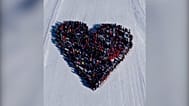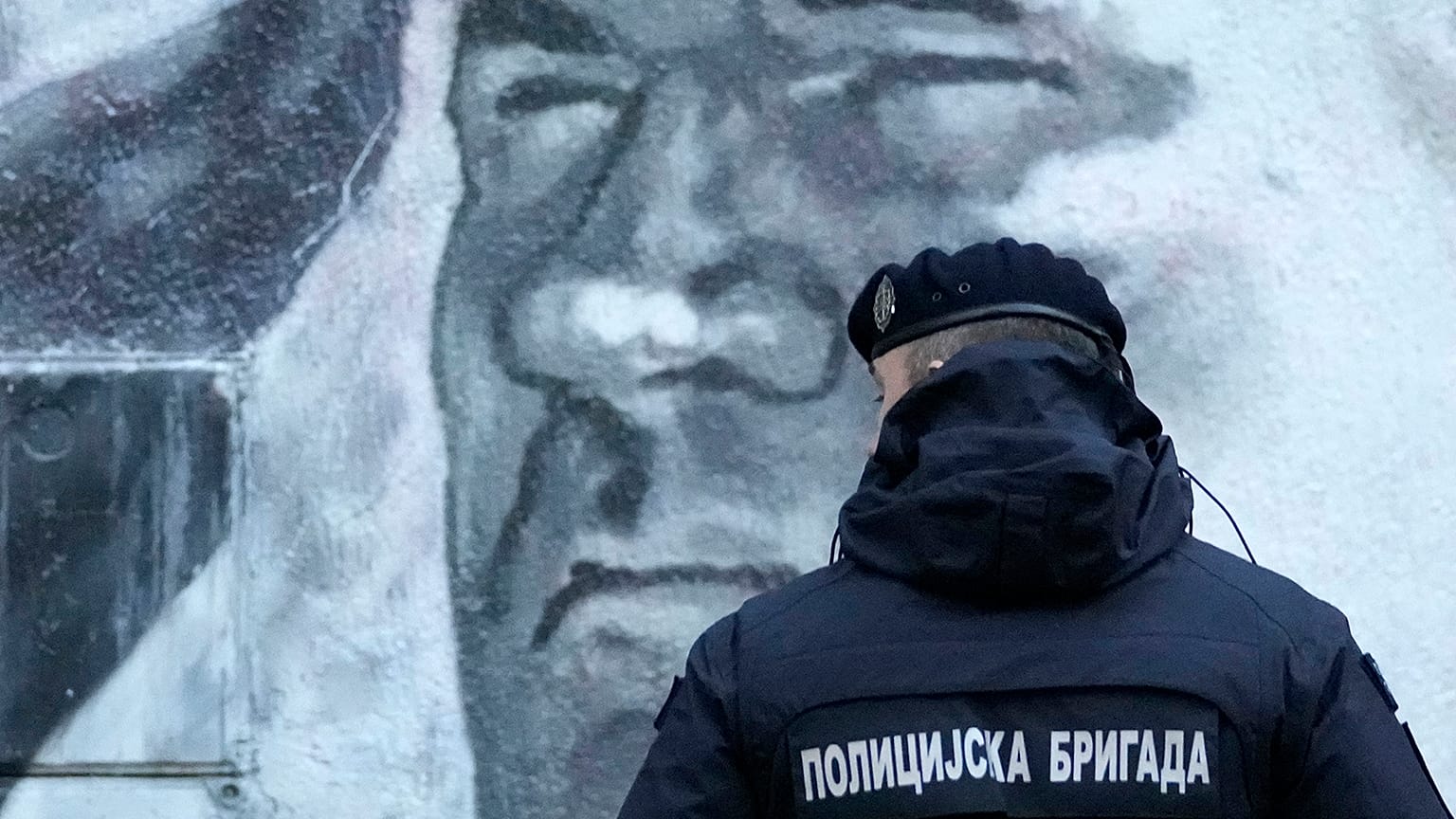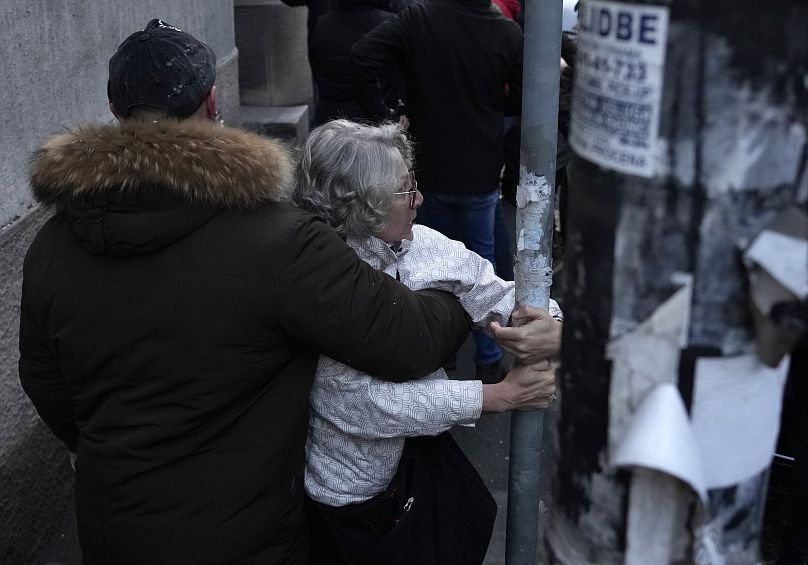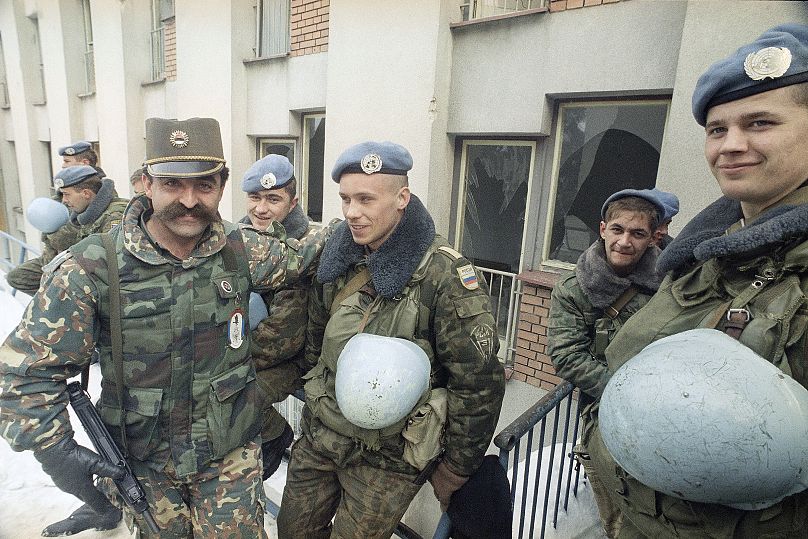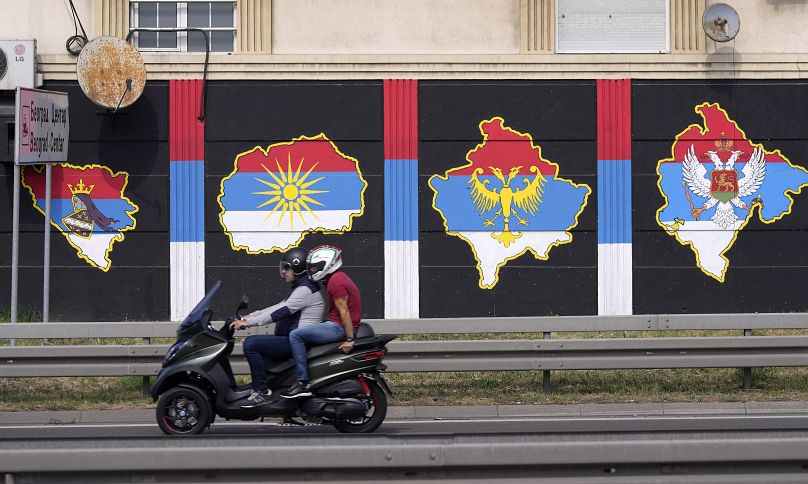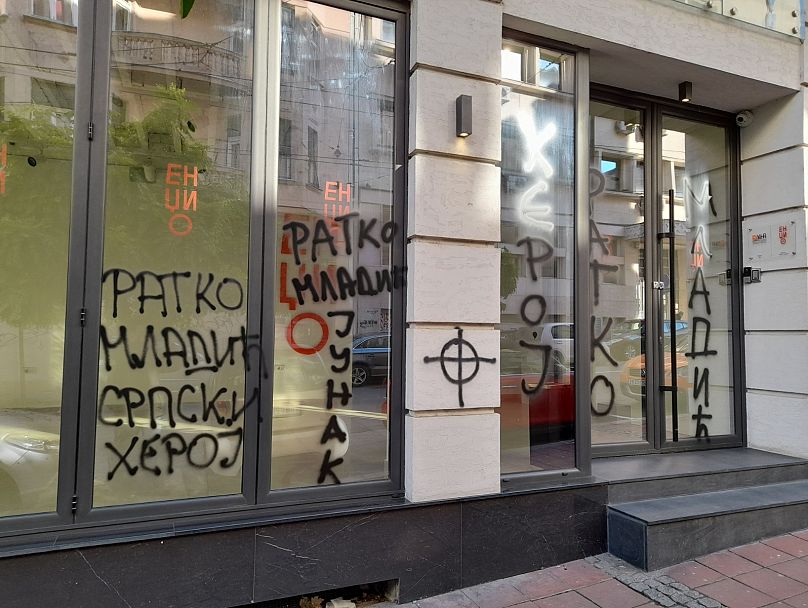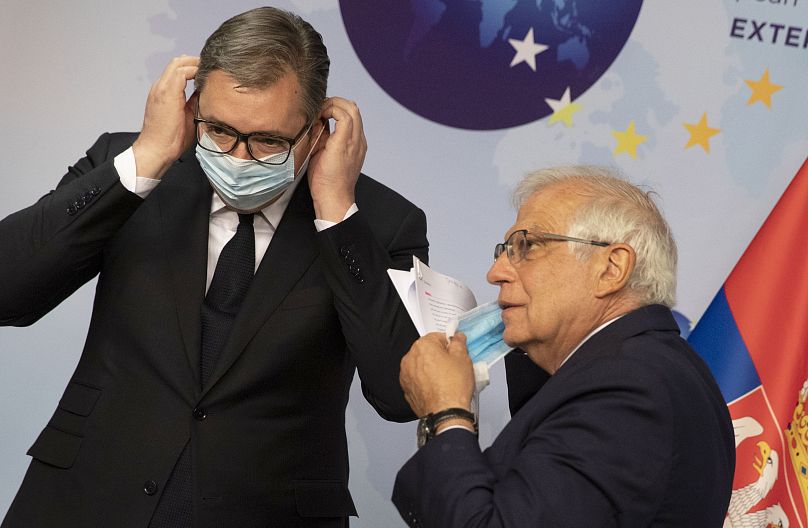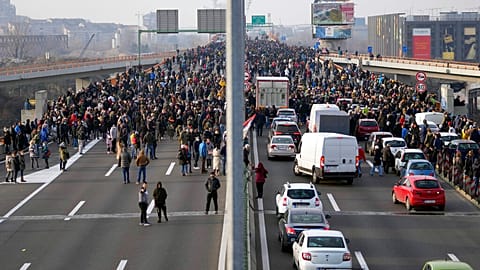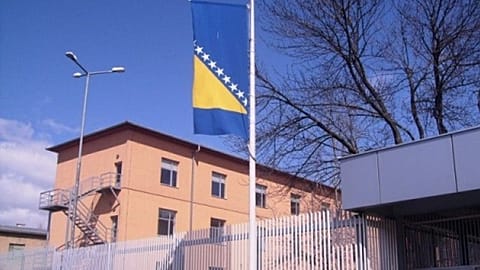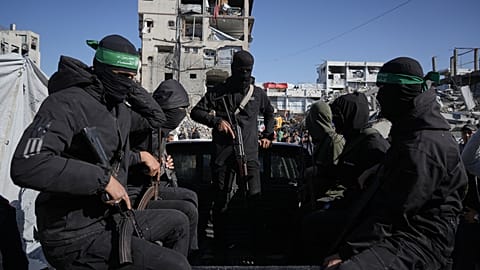In Belgrade, a mural of war criminal Ratko Mladić has a city divided
A street corner in the centre of Serbia's capital featuring a mural guarded by volunteers poses the question of whether the country's society and its politicians have the strength to deal with its wartime past.
For several weeks now, the question of whether or not Belgrade will be a capital that allows street art honouring convicted war criminals on its streets has plagued the Serbian public debate.
A tag war of sorts has unfolded between those who are defending murals and other scribbles dedicated to Ratko Mladić -- found in ever-increasing numbers across the city -- and those who are trying to cover them up.
Many see it as a symbolic moment in defining what sort of image Serbia wants to project to the world after the conflicts of the 1990s.
The face of a younger Mladić -- painted on the side of a building in the Vračar neighbourhood usually known for its hip cafes and restaurants -- ignited the standoff.
The inscription “We are thankful to your mother, general” accompanies the portrait of a younger Mladić as he delivers a military salute, while also sporting an army cap reminiscent of those worn by Serbian generals in World War I.
Since it first went up in July, every couple of days activists would throw buckets of paint at it, effectively covering it up, followed by those who would clean it up — a task helped by the fact that it is covered with a protective coat of clear lacquer.
War criminals as a communal issue
The residents of the building the mural was painted on filed an official complaint requesting that it be removed. Local authorities responded saying the mural should be cleared either by the city or the residents themselves. Five months later, it is still there.
The major escalation between the mural’s supporters and detractors occurred on November 9, a date celebrated in Europe as the International Day Against Fascism and Antisemitism.
Human rights activists announced they would hold a clean-up event on that date and remove the mural once and for all.
However, Belgrade police announced the protest would be banned since it represented a security risk.
Two women, Aida Ćorović and Jelena Jaćimović, showed up anyway and pelted the mural with eggs.
Images of the two women being dragged away by several plainclothes policemen and news of their arrest sparked massive protests in the city that night, forcing riot police to cordon off the two opposing groups.
“I had no doubt in my mind that we should react in some way. There’s a red line when it comes to war crimes, war criminals and facing the past in terms of the responsibility of Serbia and its political elites,” Ćorović told Euronews.
Belgrade police said in a statement that the officers were not protecting the mural itself, but only enforcing the ban on gatherings.
Serbia's interior minister, Aleksandar Vulin, who came to the scene late that night, made headlines as he called the gathering of activists "vile and led by evil intent".
After the human rights activists left, members of a right-wing nationalist group Narodna patrola or "People's Patrol," an anti-migrant organisation, stayed close to the mural, chanting slogans in support of Mladić.
The following day, Serbian president Aleksandar Vučić was adamant the police were indeed there to prevent clashes.
“If police didn’t do that, you’d be here today asking why the police didn’t protect everyone when we all knew that both groups would show up in front of that mural and that it would lead to a physical fight,” he said.
Vučić also asked why the activists chose that particular date, claiming “it was a performance meant to damage [the image of] Serbia”.
Yet someone managed to pour white paint on Mladić’s face overnight, so the mural was once again defaced the next morning.
To Vučić, this was proof that the police were, in fact, there to protect citizens.
“If police had protected the mural, no one would have destroyed the mural,” he said.
After the most recent attempt to deface it, the mural is now under constant watch. Groups of men claim to volunteer to protect it. Most recently, they set up a table with two chairs next to it.
In the meantime, another mural, dedicated to another murderous general — Draža Mihailović, World War II Serbian guerrilla fighter and convicted Nazi collaborationist — also popped up overnight, right around the corner from the Mladić one.
After many years of public campaigning supported by the nationalist political options in Serbia, Mihailović was rehabilitated in 2015 by the Belgrade Appellate Court.
The men guarding the Mladić mural, mostly very young and dressed in black, heckle at anyone who attempts to get close to it or stops for too long to take a look, chanting his name to shoo people away.
Europe’s cruellest crimes since World War II
The mural was painted after the International Criminal Tribunal for the former Yugoslavia, or ICTY, confirmed Mladić’s life sentence in June for turning large swathes of Bosnia and Herzegovina into a bloodbath during the 1992-1995 war in the country.
Among other war crimes, Mladić was convicted of genocide for the summary executions of over 8,000 Bosniaks in Srebrenica in July 1995 committed by the Bosnian Serb army under his command and his watchful gaze — an atrocity considered the worst since the end of World War II.
After Bosnia declared independence from Yugoslavia in early 1992, Bosnian Serb leaders, backed by the government in Belgrade led by Slobodan Milošević, created their own parastate and launched a military offensive aimed at ethnically cleansing as much of the country’s territory as possible from the other two ethnic groups, Bosniaks and Croats.
Bosniaks were particularly targeted for their nominal Muslim faith, with the persecution culminating in the 1995 genocide.
This is why Mladić is idealised by far-right groups, who see him as a hero in the fight against Muslim populations in the Balkans.
After the ICTY issued the first indictment against him in July 1995, Mladić stayed Commander of the Main Staff of the Bosnian Serb army until he was relieved of his duty in November 1996.
Starting then, he was a fugitive from justice in neighbouring Serbia.
He spent 15 years hiding or being hidden by friends in the Serbian intelligence service and military until he was finally apprehended at the home of a relative in Lazarevo -- a village in the north of the country -- in 2011.
But the arrest, extradition, and his eventual sentencing at The Hague did not lead to a clear condemnation of his actions by Serbian society, in whose interest he claimed to have fought.
Litmus test for Serbian politicians
Current Serbian president Vučić began his career as a far-right nationalist under the auspices of the Serb Radical Party of Vojislav Šešelj — another ICTY war crimes indictee — and served as minister of information under Milošević.
In 2007, he famously covered the street signs on Zoran Đinđić Boulevard in Belgrade with “Ratko Mladić Street” stickers, in a public performance meant to blame the late PM’s government and his party, DS, for the ICTY’s repeat requests for Mladić’s arrest and extradition.
Serbian prime minister Zoran Đinđić was assassinated by a sniper in 2003, a plot seen by many as an attempt to stop the country’s democratisation and significant economic and social reforms after his government deposed Milošević from power and extradited him to The Hague two years prior.
His killer, Zvezdan Jovanović — a member of the Red Berets, Serbian special police forces favoured by Milošević for special operations in Croatia, Bosnia, and Kosovo — was sentenced to 40 years in prison.
The court also doled out a 137-year sentence for the assassination to Milorad Ulemek Legija, the Red Berets’ wartime commander also affiliated with the Zemun Clan, one of Belgrade’s most notorious mafia groups.
Since the 2007 incident, Vučić has attempted to distance himself from both his criticism of Đinđić and his support of Mladić, mostly by remaining silent.
He also refuses to comment on constant rumours of Ulemek’s possible pardon, while also not getting involved in the demands for the pardon of Jovanović.
War criminals as heroes — by popular demand
Over the past couple of months, the initiative to release Đinđić’s shooter turned into a full-fledged campaign, with signatures being collected in a number of cities in Serbia and publicly backed by another sentenced war criminal, Dragan Vasiljković — better known as Kapetan Dragan, his wartime moniker.
After the protests against the Mladić mural in Belgrade, Vučić stated that he only talks about Ulemek or Mladić when questioned about it by the press.
“I’ve never mentioned Milorad Ulemek Legija except when you ask me something [about him]. Other people mention Ratko Mladić, and I only mention those people upon your inquiry,” Vučić said at a press conference in Čačak in mid-November, following a display of Serbian military capabilities.
“I talk about factories, our army, the energy sector,” he concluded.
But although Vučić admitted in 2010 that “a horrible, horrifying crime” was committed in Srebrenica, claiming he was “ashamed for having to say that those who committed the crime belong to the same people” as he does, this never translated into a full recognition of what occurred as being genocide, or public condemnation of Mladić.
Ćorović, a decades-long peace activist, believes that the inability or the lack of desire by the current political leaders in the country is the result of a new generation of leaders sticking to the tried-and-tested strategies of their predecessors.
“We should be under no illusions that the party now called SNS is any different from when it was the Radical Party. It’s the same group of people, except for Slobodan Milošević.”
“Vučić was Vojislav Šešelj’s footman, and [current speaker of parliament] Ivica Dačić was Milošević’s. It’s only natural that two or three decades later, it’s nothing more than a generational change,” she said, “and you can’t expect those who profited from those politics to now shoot themselves in the foot.”
In the streets of Belgrade, matters only seem to have escalated since November 9.
After the attempt to remove the Mladić mural on Njegoševa, graffiti saying “Ratko Mladić, Serb hero” appeared on façades across Belgrade, and photographs of new murals have been widely shared on social media.
In response, activists started painting The Flower of Srebrenica, an eleven-petalled green-and-white symbol honouring the victims of the 1995 genocide on various buildings.
Stickers with the inscription, “Ratko Mladić, war criminal” have also appeared — one of them right next to the mural, but it did not last long.
Those angered by this staged two separate attacks on the offices of the Youth Initiative for Human Rights or YIHR, a Belgrade-based NGO that was one of the organisers of the November 9 event.
The main entrance to their office had Mladić’s name sprayed all over it, alongside other Serbian nationalist symbols. Around the same time, identical messages appeared at the address of Žene u crnom, or “Women in Black,” another human rights NGO.
Although YIHR immediately informed the police, its programme director Ivan Đurić said that he does not expect the case to go anywhere.
“It’s not the first time this has happened to us. Our offices were vandalised four years ago, and before that six years ago — every time the subject of the glorification of war criminals becomes a topic of debate, it’s our office and the offices of the Women in Black that end up being defaced,” he said.
“What’s also very common is that no one was ever found to be responsible for it,” Đurić explained.
“The police usually come and do their work — they take a look at surveillance camera footage, sometimes a forensics team comes, like in those American TV shows,” he said, laughing.
“But then they give the case to the local Prosecutor’s Office. We never got any further information from them, let alone any kind of satisfaction, so to speak.”
But it is obvious who is behind the last two attacks, Đurić claims: it is the same young men who defend the mural.
“The timing of the first attack correlated with the end of one of their gatherings in the Njegoševa street.”
“The spray colour is the same [as on the Mladić mural], the attackers wore the same black jackets and hoodies as those guarding it. It really doesn’t take a genius to figure out who did it.”
Vandalism has also crossed over into open threats of violence, especially online.
Đurić said that after YIHR made an appeal on social media for people to report intimidation and threats to their office, they received “dozens of cases.”
“It’s becoming all too common. A number of people who voiced their criticism of the mural or supported to those who wanted to remove it have received horrifying threats,” he explains.
These are not generic threats, he points out. “‘We know where you live,’ followed by their address, or ‘we know which small business your father owns in the neighbourhood.’”
A stain on Serbia’s image in Brussels
Đurić says that Vučić’s comments about their actions “shaming Serbia” as the country is preparing to continue its EU accession negotiations shows that the issue is more than just that of a mere mural.
“This is turning into one of the most serious tests for the current government. There isn’t much room for any lack of clarity that would satisfy both the Western governments and their nationalist base at home,” he said.
In the past, Serbian president Vučić has been able to satisfy — or at least placate — both the members of the international community such as the EU and the biggest nationalist hardliners within his voter base. With his propensity for long and often self-deprecating speeches, he would sell a potential compromise to certain voters on one day, while standing up to the West on another.
Yet the Mladić mural is a watershed moment — he can either win the undying loyalty of hardline nationalists or deliver a final blow to genocide denial. He can not have both.
“What is happening in the Njegoševa is total anarchy, and everyone seems to be relegating responsibility. There’s a street corner that is currently not run by the government, but something akin to a gang. And it needs to be resolved, one way or another, and soon.”
“This is not just a matter of dealing with the past, but also basic principles of rule of law. And the whole world is seeing it for what it is,” Đurić concluded.
Neither the prosecutor’s office nor the municipal inspection responded to multiple attempts by Euronews to contact them regarding the attacks on the YIHR office or the Njegoševa mural removal, respectively.
On Thursday, a “Ratko Mladić Serb hero” graffiti appeared again — this time on the facade of the Dom omladine, a famed cultural centre and concert venue popular among the capital’s young and alternative scene.
The plateau in front of the building is named after Milan Mladenović, the frontman of EKV — one of the most renowned Yugoslav rock bands from the New Wave period.
Mladenovic was a central figure of Belgrade’s anti-war movement in the early 1990s at a time when any public dissent against Milošević’s rule was dangerous, especially if done by someone famous.
Mladenović became a cult hero both for his band’s melancholic songs and his opposition to the rampant nationalism and subsequent violence.
The activists who called for an ad-hoc gathering on Thursday covered the tag with stickers saying “Ratko Mladić war criminal” among protests from the concert hall employees and police noting their presence.
On Thursday evening, activists returned to remove the graffiti themselves. Once again, the police arrived.
During a live video on Twitter, at least one person was seen getting hit in the tense exchange, making her drop her phone.
That graffiti ended up getting removed — for the time being.
Ćorović expects the situation to further deteriorate, with the tit-for-tat likely to become more dangerous as long as the authorities do not put a stop to the increasing threats of violence coming from the far-right.
She says she is not upset with the young men who are at the forefront of the recent spate of glorification of war criminals, but she is still wary of what they might do next.
“These young men are filled with hate, they come from the margins of the society, they come from poverty — there are many reasons why they’re so angry at the world around them,” Čorović pointed out.
“And when you give those young men a modicum of importance — and I’ve seen this elsewhere, be it with religious radicals or football hooligans — then they become the foot soldiers of an ideology who are now expected to settle scores with us who think differently,” she concluded.
Every weekday at 19h CET, Uncovering Europe brings you a European story that goes beyond the headlines. Download the Euronews app to get a daily alert for this and other breaking news notifications. It's available on Apple and Android devices.




